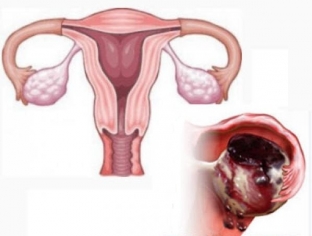Acute abdomen is one of the most dangerous and life-threatening conditions in gynecology. Acute abdomen syndrome implies the occurrence of acute pathological conditions of the internal reproductive organs of a woman, which can lead to serious complications and therefore require immediate hospitalization of the patient and the start of an effective therapeutic regimen. One of the diseases that can cause an acute abdomen is ovarian apoplexy - a hemorrhage that occurs as a result of rupture of its tissues. This condition leads to significant blood loss and extremely dangerous consequences. Why ovarian apoplexy occurs - read on.
The main causes of ovarian apoplexy
Apoplexy of the ovary (apoplexia ovarii) is an acute hemorrhage in the ovary. This condition can develop as a result of rupture of the vessels of the Graafian vesicle, stroma, or ovarian cysts, resulting in bleeding into the abdominal cavity. Among all gynecological pathology, ovarian apoplexy is not very common, but this disease tends to recur in almost 70% of cases. The occurrence of ovarian apoplexy is an urgent condition that requires urgent, most informative diagnosis and effective treatment.
Ovarian apoplexy:
- etiological factors of ovarian apoplexy;
- how age and phase of the cycle affect the occurrence of ovarian apoplexy;
- classification of ovarian apoplexy depending on symptoms and blood loss.
Etiological factors of ovarian apoplexy
Rupture of ovarian tissues can occur as a result of exposure to completely different factors. There are the following main causes of ovarian apoplexy:
- inflammatory diseases of the reproductive organs, which lead to sclerosis of the tissues of the ovary and its vessels;
- blood diseases and prolonged use of anticoagulants, which lead to disorders of the blood coagulation system;
- exogenous factors: trauma to the pelvic organs, physical exertion, douching or improper vaginal examination, etc.;
- endogenous factors: pathological position of the uterus, tumor or adhesions in the pelvis, etc.;
- hormonal disorders of a woman, contributing to hyperemia of ovarian tissues;
- stress factors and significant psycho-emotional stress.

How does age and phase of the cycle affect the occurrence of ovarian apoplexy
Ovarian apoplexy is a pathological condition that can occur even when the body is completely calm. At the same time, some patterns can be distinguished in the occurrence of rupture of ovarian tissues:
- ovarian apoplexy can occur in women of absolutely different age categories: both in adolescence and in the premenopausal period. At the same time, the peak of the occurrence of this disease is observed in women aged 20-35 years;
- certain "critical moments" for the occurrence of ovarian apoplexy are distinguished: the middle and the second phase of the menstrual cycle. This can be explained by increased permeability and an increase in the blood filling of the ovarian vessels at this particular time;
- several times more often tissue rupture occurs on the right ovary than on the left. It is natural that the left ovarian artery departs from the renal artery, and the right - from the aorta. Abundant blood circulation in the vessels of the right ovary is an important factor causing such a pattern in the development of pathology.
Classification of ovarian apoplexy according to symptoms and blood loss
In accordance with the characteristics of the clinical picture, the following forms of ovarian apoplexy are distinguished:
- hemorrhagic form - the clinical picture is dominated by symptoms of bleeding into the abdominal cavity;
- pain form - pain syndrome comes to the fore without signs of intra-abdominal bleeding;
- mixed form - the clinical picture combines both bleeding symptoms and pain syndrome.
According to the severity of blood loss in ovarian apoplexy, the disease is classified according to degrees:
- I degree - light blood loss, does not exceed 150 ml;
- II degree - medium blood loss, from 150 to 500 ml;
- III degree - severe blood loss, more than 500 ml.






Add a comment